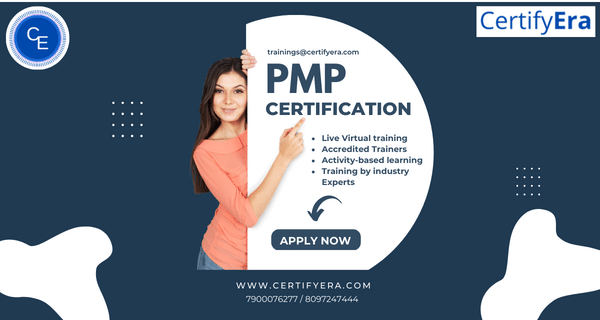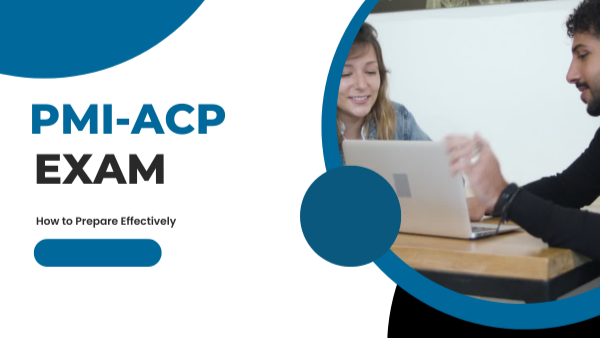
PMP: Risk Management in Agile
When we manage a project, it is unavoidable that we have to actively deal with risks. There are numerous factors that play an important role in project success or failure.
No Table of Contents available for this blog post.
Introduction to Project Risk Management:
Project management is all about diligently managing each element of project including Scope, Schedule, Risk, Quality, Resources and other subsidiary elements. When we think about Risk, it might be pertaining to any element of the project which might result in sinking the project to any extent.
Project Planning is the early phase of project life cycle. All the elements need to be planned early and need to revisit periodically to understand if there is any deviation from the original plan.
There are numerous actions a project manager can take to realign the project in case of any issues. Risk management is a continuous process throughout the project since risks continue to emerge during the lifetime of a project. To learn risk management at your pace, join our PMP self-paced learning course.
Risk management is a crucial aspect of project management that helps project managers anticipate potential problems and develop strategies to mitigate or avoid them. Effective risk management can mean the difference between a project’s success and its failure. This comprehensive guide will delve into the importance of risk management in project management, the process of identifying and analyzing risks, and strategies for managing risks to ensure project success.
The Importance of Risk Management
- Proactive Problem Solving: By identifying potential risks early, project managers can develop proactive strategies to avoid or minimize their impact, rather than reacting to problems as they arise.
- Informed Decision Making: Understanding the risks associated with a project allows managers to make more informed decisions, balancing potential benefits against possible downsides.
- Increased Project Success: Projects with effective risk management practices are more likely to meet their objectives on time and within budget.
- Stakeholder Confidence: Demonstrating a thorough risk management plan can increase stakeholders' confidence in the project’s viability and the project team's competence.
Traditional Risk management involves below activities:
- Identification of risks: Identifying and Managing risks
- Project risk management addresses both Individual project risks (affecting one or more project objectives) as well as overall project risks (affecting project as a whole)
- Reserve Analysis: Contingency reserves for known risks such as schedule or budget risks
- Reserve Analysis: Management reserves for Unknown Risks or Emergent Risks
- Project resilience: By improving on all areas of a project such as right contingency planning, flexible project processes, empowered project team, clear input from stakeholders etc.
- Integrated risk management: A coordinated approach to enterprise-wide risk management
- In traditional model, Risks are primary identified and documented at the beginning of the project
- In traditional model, Risks are also managed as and when they surface through the project but frequent reviews are not carried out to identify risks at regular internals.
Agile Approach in Risk Management:
- Frequent reviews of incremental work products - In Agile, we need to perform frequent reviews of work products and take necessary actions. Frequent reviews help in surfacing risks early and cost less
- Cross-functional project teams accelerate knowledge sharing - Interactions within and outside team boosts project communications which helps to identify risks which could otherwise might get missed due to poor communication
- Risks are identified, analyzed and managed during each iteration - In each iteration, project team carries out risk management which makes it continuous process enabling continuous improvement
- Risks cost less/none as they are captured early due to frequent reviews - Frequent reviews enable better project management and increases chances of project success, yet staying within the constraints of project such as scope, schedule, cost, resources etc
The Risk Management Process
The risk management process in project management typically involves five key steps: identification, analysis, prioritization, response planning, and monitoring and control.
-
Risk Identification
- Brainstorming Sessions: Engage the project team and stakeholders in brainstorming sessions to identify potential risks.
- SWOT Analysis: Use SWOT (Strengths, Weaknesses, Opportunities, Threats) analysis to uncover risks from different angles.
- Checklists and Templates: Utilize risk checklists and templates based on past projects to ensure all common risks are considered. Learn these techniques in detail in our PMP live workshop.
-
Risk Analysis
- Qualitative Analysis: Assess the impact and likelihood of each risk using qualitative methods such as probability and impact matrices.
- Quantitative Analysis: For more significant risks, perform quantitative analysis using techniques such as Monte Carlo simulation or decision tree analysis to understand potential impacts in numerical terms. You may learn these concepts at your pace in our PMP E-learning course.
-
Risk Prioritization
- Risk Ranking: Rank risks based on their potential impact and likelihood to determine which risks need immediate attention.
- Risk Matrix: Use a risk matrix to visualize and prioritize risks, categorizing them into high, medium, and low priority.
-
Risk Response Planning
- Avoidance: Change the project plan to eliminate the risk or protect the project objectives from its impact.
- Mitigation: Reduce the likelihood or impact of the risk to an acceptable level.
- Acceptance: Acknowledge the risk and decide to deal with it if it occurs.
- Transference: Shift the impact of the risk to a third party, such as through insurance or outsourcing.
-
Risk Monitoring and Control
- Regular Reviews: Conduct regular risk reviews to track identified risks, identify new risks, and evaluate the effectiveness of risk responses.
- Risk Audits: Perform risk audits to ensure that risk management practices are being followed correctly.
- Status Meetings: Include risk status as a regular agenda item in project status meetings to keep the team informed and engaged in managing risks.
Risk Management Strategies
-
Develop a Risk Management Plan: Create a detailed plan that outlines how risk management will be conducted throughout the project. This plan should define roles and responsibilities, risk thresholds, and the process for risk identification, analysis, and response.
-
Foster a Risk-Aware Culture: Encourage an organizational culture that values proactive risk management. Ensure that all team members are aware of the importance of identifying and managing risks and feel empowered to report potential risks without fear of blame.
-
Use Risk Management Software: Leverage technology to enhance your risk management process. Risk management software can help with tracking, analyzing, and reporting risks, making the process more efficient and effective.
-
Engage Stakeholders: Involve stakeholders in the risk management process. Their input can provide valuable insights into potential risks and their impacts. Keeping stakeholders informed about risk management efforts also helps maintain their confidence and support.
-
Continuously Improve: Risk management is an ongoing process. After each project, conduct a lessons-learned session to identify what worked well and what didn’t. Use these insights to improve your risk management practices for future projects.
Author: Anita Myana
CertifyEra is a proven expert in training and consulting. We help professionals and organizations unleash their skills. We provide training solutions on project management, Agile and process verticals.
For enquiring about various training courses, please contact us.

About Anita Ankam
Anita Ankam – Expert Project Management Instructor
Anita Ankam is a highly experienced and certified project management instructor, specializing in globally recognized methodologies such as PMP®, PMI-ACP®, DASM®, and DASSM®. With an extensive academic background, including an MBA and MSc, Anita holds multiple industry-leading certifications, including PRINCE2, PRINCE2 Agile Practitioner, CSM, ASM, ITIL, and Six Sigma Black Belt.
As an authorized training instructor, Anita has guided countless professionals in mastering project management frameworks and agile practices. Know more.
Related Posts

Featured Links
Contact us
- PMP® Certification Course |
- CAPM Certification Course |
- PMP Certification Training in Mumbai |
- PMP Certification Training in Pune |
- PMP Certification Training in Hyderabad |
- PMP Certification Training in Delhi |
- PMP Certification Training in Chennai |
- PMP Certification Training Course in Ahmedabad |
- PMP Certification Training Course in Bangalore |
- PMP Certification Training Course in Bhubaneswar |
- PMP Certification Training Course in Chandigarh |
- PMP Certification Training Course in Gandhinagar |
- PMP Certification Training Course in Faridabad |
- PMP Certification Training Course in Dombivli |
- PMP Certification Training Course in Coimbatore |
- PMP Certification Training Course in Ghaziabad |
- PMP Certification Training Course in Gurgaon |
- PMP Certification Training Course in Indore |
- PMP Certification Training Course in Jaipur |
- PMP Certification Training Course in Mysore |
- PMP Certification Training Course in Lucknow |
- PMP Certification Training Course in Kolkata |
- PMP Certification Training Course in Kochi |
- PMP Certification Training Course in Nagpur |
- PMP Certification Training Course in Navi Mumbai |
- PMP Certification Training Course in Patna |
- PMP Certification Training Course in Pimpri |
- PMP Certification Training Course in Vadodara |
- PMP Certification Training Course in Trivandrum |
- PMP Certification Training Course in Thane |
- PMP Certification Training Course in Surat |
- PMP Certification Training Course in Noida |
- PMP Certification Training Course in Visakhapatnam |
- PMP® Certification Training Course in Doha |
- PMP Certification Training in New York |
- PMP Certification Training Course in Chicago |
- PMP Certification Training in Austin |
- PMP Certification Training in Minneapolis |
- PMP Certification Training in Atlanta |
- PMP Certification Training in Dallas |
- PMP Certification Training in San Diego |
- CAPM Certification Training in Mumbai |
- CAPM Certification Training in Bangalore |
- CAPM Certification Training in Hyderabad |
- CAPM Certification Training in Delhi |
- CAPM Certification Training in Pune |
- CAPM Certification Training in Chennai |
- CAPM certification Training in Kolkata |
- CAPM certification Training in Gurgaon |
- CAPM certification Training in Noida |
- CAPM Certification Training in Ahmedabad |
- PMI Certified Professional in Managing AI (PMI-CPMAI)™ |
- PMI-RMP - PMI Risk Management Professional |
- PMI-PMOCP - PMI® Project Management Office Certified Professional
- AZ-900: Microsoft Azure Fundamentals |
- AZ-104: Microsoft Azure Administrator |
- AZ-204: Developing Solutions for Microsoft Azure |
- AZ-305: Designing Microsoft Azure Infrastructure Solutions |
- AZ-400: Designing and Implementing Microsoft DevOps Solutions |
- AZ-500: Microsoft Azure Security Technologies |
- AI-900: Microsoft Azure AI Fundamentals |
- DP-900: Microsoft Azure Data Fundamentals |
- CLF-C02: AWS Certified Cloud Practitioner |
- GCP-FC: Cloud Digital Leader |
- GCP-ACE: Associate Cloud Engineer |
- GCP-PCA: Professional Cloud Architect |
- GCP-PCD: Professional Cloud Developer |
- GCP-PCE: Professional Cloud DevOps Engineer |
- GCP-PDE: Professional Data Engineer |
- GCP-PCNE: Professional Cloud Network Engineer |
- GCP-PCSE: Professional Cloud Security Engineer |
- GCP-ML: Professional Machine Learning Engineer |
- GCP-PBA: Professional Business Intelligence Analyst |
- DP-100: Designing and Implementing a Data Science Solution on Azure |
- DP-203: Data Engineering on Microsoft Azure
- PMP® is a registered mark of the Project Management Institute, Inc.
- CAPM® is a registered mark of the Project Management Institute, Inc.
- PMI-ACP® is a registered mark of the Project Management Institute, Inc.
- Certified ScrumMaster® (CSM) ia a registered trademark of SCRUM ALLIANCE®
- While we strive to ensure that all prices listed on our website are accurate, we reserve the right to modify them at any time without prior notice.
Copyright © Certifyera Consulting Services. All Rights Reserved | Designed and Developed by WebAnaya

.png)

